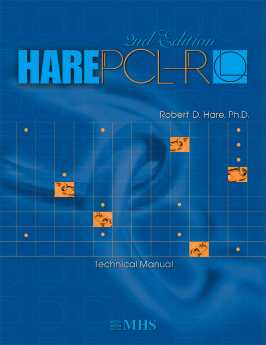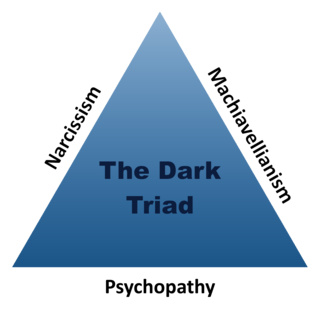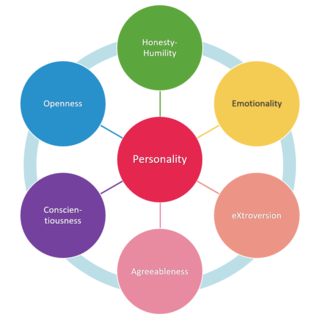Related Research Articles
Antisocial personality disorder is a personality disorder characterized by a limited capacity for empathy as well as a difficulty sustaining long-term relationships. A long-term pattern of disregard or violation of the rights of others and a contemptuous or vindictive attitude are often apparent, as well as a history of rule-breaking that can sometimes include law-breaking, manipulation, compulsive lying for amusement or personal gain, a tendency towards chronic boredom and substance abuse, and impulsive and aggressive behavior. Antisocial behaviors often have their onset before the age of 8, and in nearly 80% of ASPD cases, the subject will develop their first symptoms by age 11. The prevalence of ASPD peaks in people age 24 to 44 years old, and often decreases in people age 45 to 64 years. In the United States, the rate of antisocial personality disorder in the general population is estimated between 0.5 and 3.5 percent. In a study, a random sampling of 320 newly incarcerated offenders found ASPD was present in over 35 percent of those surveyed. One out of 17 (6%) of divorces involves a person affected by ASPD.

Sadistic personality disorder is a personality disorder defined by a pervasive pattern of sadistic and cruel behavior. People with this disorder were thought to have desired to control others. It was believed they accomplish this through the use of physical or emotional violence. This diagnosis appeared in an appendix of the Diagnostic and Statistical Manual of Mental Disorders (DSM-III-R). The later versions of the DSM do not include it. It was removed as psychiatrists believed it would be used to legally excuse sadistic behavior.
Malignant narcissism is a psychological syndrome comprising an extreme mix of narcissism, antisocial behavior, aggression, and sadism. Grandiose, and always ready to raise hostility levels, the malignant narcissist undermines families and organizations in which they are involved, and dehumanizes the people with whom they associate.
Psychopathy is a mental health condition characterized by persistent antisocial behavior, impaired empathy and remorse, and bold, disinhibited, and egotistical traits. Different conceptions of psychopathy have been used throughout history that are only partly overlapping and may sometimes be contradictory.

The Psychopathy Checklist or Hare Psychopathy Checklist-Revised, now the Psychopathy Checklist—revised (PCL-R), is a psychological assessment tool that is commonly used to assess the presence and extent of the personality trait psychopathy in individuals—most often those institutionalized in the criminal justice system—and to differentiate those high in this trait from those with antisocial personality disorder, a related diagnosable disorder. It is a 20-item inventory of perceived personality traits and recorded behaviors, intended to be completed on the basis of a semi-structured interview along with a review of "collateral information" such as official records. The psychopath tends to display a constellation or combination of high narcississtic, borderline, and antisocial personality disorder traits, which includes superficial charm, charisma/attractiveness, sexually seductive and promiscuity, affective instability, suicidality, lack of empathy, feelings of emptiness, self-harm, and splitting. In addition, sadistic and paranoid traits are usually also present.

The dark triad is a psychological theory of personality, first published by Delroy L. Paulhus and Kevin M. Williams in 2002, that describes three notably offensive, but non-pathological personality types: Machiavellianism, sub-clinical narcissism, and sub-clinical psychopathy. Each of these personality types is called dark because each is considered to contain malevolent qualities.
The Sixteen Personality Factor Questionnaire (16PF) is a self-report personality test developed over several decades of empirical research by Raymond B. Cattell, Maurice Tatsuoka and Herbert Eber. The 16PF provides a measure of personality and can also be used by psychologists, and other mental health professionals, as a clinical instrument to help diagnose psychiatric disorders, and help with prognosis and therapy planning. The 16PF can also provide information relevant to the clinical and counseling process, such as an individual's capacity for insight, self-esteem, cognitive style, internalization of standards, openness to change, capacity for empathy, level of interpersonal trust, quality of attachments, interpersonal needs, attitude toward authority, reaction toward dynamics of power, frustration tolerance, and coping style. Thus, the 16PF instrument provides clinicians with a normal-range measurement of anxiety, adjustment, emotional stability and behavioral problems. Clinicians can use 16PF results to identify effective strategies for establishing a working alliance, to develop a therapeutic plan, and to select effective therapeutic interventions or modes of treatment. It can also be used within other areas of psychology, such as career and occupational selection.
Social adroitness is a personality trait measured in the Jackson Personality Inventory and the Jackson Personality Inventory-Revised. Adroitness is not explicitly measured by these tests, but rather the characteristics are measured through different scales.
In psychology, grandiosity is a sense of superiority, uniqueness, or invulnerability. It may be expressed by exaggerated beliefs regarding one's abilities, the belief that few other people have anything in common with oneself, and that one can only be understood by a few, very special people. The personality trait of grandiosity is principally associated with narcissistic personality disorder (NPD), but also is a feature in the occurrence and expression of antisocial personality disorder, and the manic and hypomanic episodes of bipolar disorder.
In psychology, manipulation is defined as subterfuge designed to influence or control another, usually in a manner which facilitates one's personal aims. Definitions for the term vary in which behavior is specifically included, influenced by both culture and whether referring to the general population or used in clinical contexts. Manipulation is generally considered a dishonest form of social influence as it is used at the expense of others.

The HEXACO model of personality structure is a six-dimensional model of human personality that was created by Ashton and Lee and explained in their book, The H Factor of Personality, based on findings from a series of lexical studies involving several European and Asian languages. The six factors, or dimensions, include Honesty-Humility (H), Emotionality (E), Extraversion (X), Agreeableness (A), Conscientiousness (C), and Openness to Experience (O). Each factor is composed of traits with characteristics indicating high and low levels of the factor. The HEXACO model was developed through similar methods as other trait taxonomies and builds on the work of Costa and McCrae and Goldberg. The model, therefore, shares several common elements with other trait models. However, the HEXACO model is unique mainly due to the addition of the Honesty-Humility dimension.
Reinforcement sensitivity theory (RST) proposes three brain-behavioral systems that underlie individual differences in sensitivity to reward, punishment, and motivation. While not originally defined as a theory of personality, the RST has been used to study and predict anxiety, impulsivity, and extraversion. The theory evolved from Gray's biopsychological theory of personality to incorporate findings from a number of areas in psychology and neuroscience, culminating in a major revision in 2000. The revised theory distinguishes between fear and anxiety and proposes functionally related subsystems. Measures of RST have not been widely adapted to reflect the revised theory due to disagreement over related versus independent subsystems. Despite this controversy, RST informed the study of anxiety disorders in clinical settings and continues to be used today to study and predict work performance. RST, built upon Gray's behavioral inhibition system (BIS) and behavioral activation system (BAS) understanding, also may help to suggest predispositions to and predict alcohol and drug abuse. RST, a continuously evolving paradigm, is the subject of multiple areas of contemporary psychological enquiry.
The Psychopathic Personality Inventory (PPI-Revised) is a personality test for traits associated with psychopathy in adults. The PPI was developed by Scott Lilienfeld and Brian Andrews to assess these traits in non-criminal populations, though it is still used in clinical populations as well. In contrast to other psychopathy measures, such as the Hare Psychopathy Checklist (PCL), the PPI is a self-report scale, rather than interview-based, assessment. It is intended to comprehensively index psychopathic personality traits without assuming particular links to anti-social or criminal behaviors. It also includes measures to detect impression management or careless responding.
The Levenson Self-Report Psychopathy scale (LSRP) is a 26-item, 4-point Likert scale, self-report inventory to measure primary and secondary psychopathy in non-institutionalised populations. It was developed in 1995 by Michael R. Levenson, Kent A. Kiehl and Cory M. Fitzpatrick. The scale was created for the purpose of conducting a psychological study examining antisocial disposition among a sample of 487 undergraduate students attending psychology classes at the University of California, Davis.
The person–situation debate in personality psychology refers to the controversy concerning whether the person or the situation is more influential in determining a person's behavior. Personality trait psychologists believe that a person's personality is relatively consistent across situations. Situationists, opponents of the trait approach, argue that people are not consistent enough from situation to situation to be characterized by broad personality traits. The debate is also an important discussion when studying social psychology, as both topics address the various ways a person could react to a given situation.
The Honesty-Humility factor of the HEXACO model of personality is one of the six basic personality traits. Honesty-Humility is a basic personality trait representing the tendency to be fair and genuine when dealing with others, in the sense of cooperating with others, even when someone might utilize them without suffering retaliation. People with very high levels of the Honesty-Humility avoid manipulating for personal gain, feel little desire to break rules, are uninterested in wealth and luxuries, and feel no special right to elevated social status. Conversely, persons with very low levels on this scale will compliment others to get whatever they want, are inclined to break the rules for personal gains, are motivated by material gain, and feel a strong sense of self-importance.
The alternative five model of personality is based on the claim that the structure of human personality traits is best explained by five broad factors called impulsive sensation seeking (ImpSS), neuroticism–anxiety (N-Anx), aggression–hostility (Agg-Host), sociability (Sy), and activity (Act). The model was developed by Marvin Zuckerman and colleagues as a rival to the well-known five factor model of personality traits and is based on the assumption that "basic" personality traits are those with a strong biological-evolutionary basis. One of the salient differences between these two models is that the alternative five model lacks any equivalent to the dimension called openness to experience in the five factor model.
Delroy L. Paulhus is a personality psychology researcher and professor. He received his doctorate from Columbia University and has worked at the University of California, Berkeley and the University of California, Davis. Currently, Paulhus is a professor of psychology at the University of British Columbia in Vancouver, Canada where he teaches undergraduate and graduate courses. He is best known for being the co creator of the dark triad, along with fellow researcher Kevin Williams.
The Dark Triad Dirty Dozen (DTDD) is a brief 12-question personality inventory test to assesses the possible presence of three co-morbid socially maladaptive, dark triad traits: Machiavellianism, narcissism, and psychopathy. The DTDD was developed to identify the dark triad traits among subclinical adult populations. It is a screening test. High scores on the DTDD do not necessary correlate with clinical diagnoses.

In the field of personality psychology, Machiavellianism is a personality trait centered on manipulativeness, callousness, and indifference to morality. The psychological trait derives its name from the political theorist Niccolò Machiavelli, as psychologists Richard Christie and Florence Geis used edited and truncated statements inspired by his works to study variations in human behaviors. Their Mach IV test, a 20-question, Likert-scale personality survey, became the standard self-assessment tool and scale of the Machiavellianism construct. Those who score high on the scale are more likely to have a high level of deceitfulness and a cynical, unempathetic temperament.
References
- 1 2 3 4 Moshagen, M., Hilbig, B. E., & Zettler, I. (2018). The dark core of personality. Psychological Review, 125, 656-688.
- ↑ Zettler, I., Moshagen, M., & Hilbig, B. E. (2021). Stability and Change: The Dark Factor of Personality Shapes Dark Traits. Social Psychological and Personality Science, 12, 974-983
- ↑ Hilbig, B. E., Moshagen, M., Thielmann, I., & Zettler, I. (2022). Making rights from wrongs: The crucial role of beliefs and justifications for the expression of aversive personality. Journal of Experimental Psychology: General.
- ↑ Bandura, A. (2016). Moral disengagement: How people do harm and live with themselves. Worth Publishers.
- ↑ Hilbig, B. E., Thielmann, I., Zettler, I., & Moshagen, M. (2022). The dispositional essence of proactive social preferences: The dark core of personality vis-à-vis 58 traits. Psychological Science.
- ↑ Thielmann, I., Spadaro, G., & Balliet, D. (2020). Personality and prosocial behavior: A theoretical framework and meta-analysis. Psychological Bulletin, 146, 30–90.
- ↑ Moshagen, M., Zettler, I., & Hilbig, B. E. (2020). Measuring the dark core of personality. Psychological Assessment, 32, 182-196.
- ↑ "D: The Dark Factor of Personality". darkfactor.org.
- ↑ https://qst.darkfactor.org/